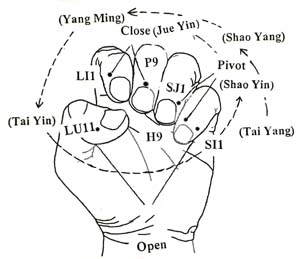Yin Yang
/ I wouldn't be a martial artist at all if I didn't love the "doi!" moments where I hit my self-on the forehead because I've just realized how wrongly I've been practicing for x number of years. That's because those moments are transitions to new freedoms.
I wouldn't be a martial artist at all if I didn't love the "doi!" moments where I hit my self-on the forehead because I've just realized how wrongly I've been practicing for x number of years. That's because those moments are transitions to new freedoms.
Yinyang theory is among the most basic aspects of North Asian cosmology so I'm not going t go into it here because most of my readers already know it.
What got me excited is that I suddenly came to understand the yin and yang meridians in a way I never had before. Or rather, I put together a bunch of discrete experiences into a coherent whole. So I'll just make a list.
Zhang Xuexin taught that qi rises up the meridians on the insides and back of the legs, then moves to the yang meridians coming up the the back over the head and out along the tan side of the arms, and then comes from the palms inward along the yin meridians of the arms and down the face and then down the front of the body and then, moves down the yang meridians of legs which are on the outside edges and along the front. Kumar Frantzis taught the same thing. And generally this is part of any heaven-earth qigong series.
Liu Ming expained that meridian flow, like the flow of qi in meditation, happens by itself, of its own accord, effort only inhibits it.
Markus Brinkman, on his roof in Taiwan, explained and demonstrated channel theory as it applies to martial arts using a finger counting system. He was astonished at how fast I picked it up. I puzzled on it for awhile and did a bunch of experiments. The idea is that force is generated, defused/transformed and transmitted along specific groups of meridians in sequence. The theory is in this book: Applied Channel Theory in Chinese Medicine Wang Ju-Yi's Lectures on Channel Therapeutics.
I figured out through my own experiments that the yang meridians are better for defense and yin meridians are better for attacking. In the language of tai chi, pengjin takes force on the yang meridians, jijin issues force via the yin meridians. A corollary for this is that yin is gathered when our structure is organized towards the inside edge of the feet, yang is gathered when our structure is organized towards the outside edge of the feet.
In an attempt to reduce all structural power (jin/jing) in my body I figured out that I could put my foot down during baguazhang walking as if it were a vacuum cleaner, allowing qi to draw inward as my foot takes weight.
George Xu said to me sometime in the last year, "The yin and yang meridians have different jobs."
Anyway, all this fit together for me recently. All these things have to happen at once --simultaneously and continuously. Without this piece, we can not achieve an 'I know you, you don't know me,' situation. Without the crystal clear differentiation of the roles of the yin and yang meridians, the dantian can not do its job of meeting our opponent before our mass does.
It wasn't that hard to say, and no doubt, I believed many times over the years that I understood it intellectually and physically. But until it was happening in my body under the pressure of testing and resistance, it was just words.
There are so many ways to be wrong, it feels good to get a few more of them out of the way.
• For more background read this article on making a sandwich. Or for tai chi structure theory read this. For the concept and rationale of reducing jing/jin read here.
